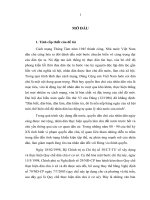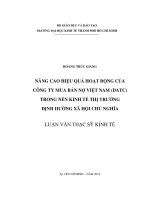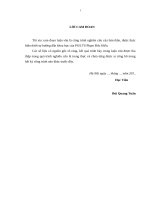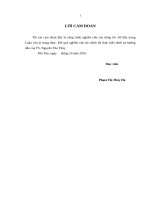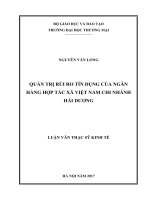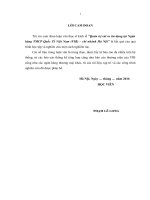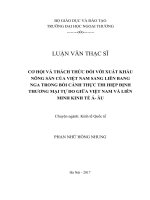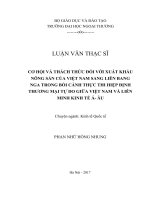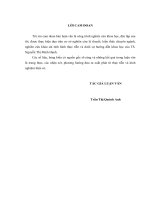(Luận văn thạc sĩ) the factors affecting talent’s loyalty in sales department of companies in viet nam
Bạn đang xem bản rút gọn của tài liệu. Xem và tải ngay bản đầy đủ của tài liệu tại đây (2.86 MB, 97 trang )
ĐẠI HỌC QUỐC GIA HÀ NỘI
KHOA QUẢN TRỊ VÀ KINH DOANH
---------------------
PHẠM THUÝ HỒNG
THE FACTORS AFFECTING TALENT’S LOYALTY IN SALES
DEPARTMENT OF COMPANIES IN VIET NAM
CÁC NHÂN TỐ ẢNH HƯỞNG ĐẾN LÒNG TRUNG THÀNH
CỦA NHÂN TÀI TRONG BỘ PHẬN BÁN HÀNG
CỦA CÁC CÔNG TY TẠI VIỆT NAM.
LUẬN VĂN THẠC SĨ QUẢN TRỊ KINH DOANH
HÀ NỘI - 2020
ĐẠI HỌC QUỐC GIA HÀ NỘI
KHOA QUẢN TRỊ VÀ KINH DOANH
---------------------
PHẠM THUÝ HỒNG
THE FACTORS AFFECTING TALENT’S LOYALTY IN SALES
DEPARTMENT OF COMPANIES IN VIET NAM
CÁC NHÂN TỐ ẢNH HƯỞNG ĐẾN LÒNG TRUNG THÀNH
CỦA NHÂN TÀI TRONG BỘ PHẬN BÁN HÀNG
CỦA CÁC CÔNG TY TẠI VIỆT NAM.
Chuyên ngành: Quản trị kinh doanh
Mã số: 60 34 01 02
LUẬN VĂN THẠC SĨ QUẢN TRỊ KINH DOANH
NGƯỜI HƯỚNG DẪN KHOA HỌC: TS. PHẠM ANH TUẤN
HÀ NỘI - 2020
DECLARATION
The author confirms that the research outcome in the thesis is the result of
author’s independent work during study and research period and it is not yet
published in other’s research and article.
The other’s research result and documentation (extraction, table, figure,
formula, and other document) used in the thesis are cited properly and the
permission (if required) is given.
The author is responsible in front of the Thesis Assessment Committee,
Hanoi School of Business, and the laws for above-mentioned declaration.
Hanoi, 31st of August, 2019
Pham Thuy Hong
i
ACKNOWLEDGEMENT
I have gained huge knowledge, skill and insights from my MBA course. The
course raises my capacity of administration and management up to the next level.
The study "The factors affecting talent’s loyalty in Sales Department of
companies in Viet Nam" is chosen to conduct for my graduation thesis based on
my experience in the industry as well as precious knowledge an I gained from MBA
program at HSB after valuable months studying here.
I declare that this is a true copy of my thesis. The content of this thesis has
been approved by the committee of Vietnam National University, Hanoi – Hanoi
School of Business and Management (HSB). This thesis has not been submitted for
a higher degree to any other University or Institution.
In order to finish this project successfully, I have received many helps,
supports and guidance from many people who I would like to thank sincerely.
First of all, I would like to express my deep gratitude for Dr. Pham
Hung Hiep and his research coach centre for all profression assistance
during data analysis process. I also would like to thank all the professors of
MBA program, especially – my supervisors, Dr. Pham Anh Tuan.
Then I would like to thank deeply to my friends, my partners, respondents
and interviewees who allowed me to gather enough data for this research. Finally, I
would like to express my thanks to my husband, my family, my fellow friends who
always stand by me during the past two years and encourages me to keep moving
from the beginning of my study.
Hanoi, 31st of August 2019
Pham Thuy Hong
ii
TABLE OF CONTENTS
DECLARATION ........................................................................................................ i
ACKNOWLEDGEMENT ......................................................................................... ii
ABBREVIATION .......................................................................................................v
LIST OF TABLES .................................................................................................... vi
LIST OF FIGURES.................................................................................................. vii
INTRODUCTION .......................................................................................................1
CHAPTER 1. THEORETICAL BACKGROUND OF TALENT’S LOYALTY
AND FACTORS AFFECTING TALENT’S LOYALTY ..........................................7
1.1. Talent’s loyalty.....................................................................................................7
1.1.1. Concept of Talent ..........................................................................................7
1.1.2. Talent’s loyalty ..............................................................................................9
1.2. Factors affecting talent’s loyalty ........................................................................11
1.2.1. Empowerment ..............................................................................................12
1.2.2. Training ........................................................................................................13
1.2.3 .Teamwork ....................................................................................................15
1.2.4. Appraisal System .........................................................................................16
1.2.5. Compensation ..............................................................................................17
1.2.6. Job Satisfaction ............................................................................................17
1.3. Conceptual model...............................................................................................19
CHAPTER 2. RESEARCH METHODOLOGY ......................................................21
2.1. Research process ................................................................................................21
2.2. Research design ..................................................................................................23
2.2.1. Research model and Hypothesis ..................................................................23
2.2.2. Data collection method ................................................................................24
2.2.3. Designing Scale and Questionnaire ............................................................25
2.2.4. Data Collection Process ..............................................................................28
2.2.5. Data Analysis Procedure.............................................................................28
iii
CHAPTER 3. RESEARCH FINDINGS ...................................................................30
3.1. Data Preparation and descriptive statistics.........................................................30
3.1.1. Data Preparation ..........................................................................................30
3.1.2. Descriptive Statistics ...................................................................................32
3.2. Measurement Model Evaluation ........................................................................41
3.3. Composite factors calculation and validity tests ..............................................45
3.4. Data Analysis .....................................................................................................48
3.5. Analysis of Hypothesis conceptual talent’s loyalty model ................................49
CHAPTER 4. DISCUSSIONS AND RECOMMENDATIONS ..............................50
4.1. Discussions .........................................................................................................50
4.2. Recommendations ..............................................................................................52
CONCLUSIONS AND LIMITATIONS ..................................................................55
REFERENCES ..........................................................................................................57
APPENDIX
iv
ABBREVIATION
HRM
Human Resource Management
HR
Human Resource
TR
Talent Retention
SMEs
Small and Medium Enterprises
TL
Talent’s Loyalty
TE
Talent Empowerment
TT
Talent Training
TW
Teamwork
AS
Appraisal System
JB
Job Satisfaction
CFA
Confirmatory Factor Analysis
SEM
Structural equation modeling
v
LIST OF TABLES
Table 2.1: Hypothesis for model ...............................................................................24
Table 2.2: Detail and Source of Questionnaire .........................................................26
Table 3.1: Encoded Variables ...................................................................................30
Table 3.2: Demographic and Basic Information of Respondents .............................32
Table 3.3: Descriptive Analyses for Measurement Items .........................................40
Table 3.4: Variables in the CFA Model ....................................................................41
Table 3.5: Results of factor loading ..........................................................................42
Table 3.6: Factor loading for Confirmatory Factor Analysis ...................................43
Table 3.7: Confirmatory factor analysis for convergent and discriminant validity ..45
Table 3.8: Results of multiple fit indices ..................................................................46
Table 3.9: Variables in the SEM Model ...................................................................47
Table 3.10: Results of Structural Equation Model ....................................................47
Table 3.11: The summary of Hypotheses Testing ....................................................49
vi
LIST OF FIGURES
Figure 1: Global average turnover: overall vs. sales population ................................3
Figure 1.1. Jun et al. (2006) Conceptual model ........................................................20
Figure 2.1 : The research process and research methodology ..................................21
Figure 2.2. Talent’s Loyalty conceptual framework model ......................................23
Figure 3.1: Gender distribution among 325 respondents ..........................................34
Figure 3.2: Age distribution among 325 respondents ...............................................35
Figure 3.3: Marital Status among 325 respondents...................................................36
Figure 3.4: Marital Status among 325 respondents...................................................37
Figure 3.5: Highest level of education among 325 respondents ...............................37
Figure 3.6: Marital Status among 325 respondents...................................................38
Figure 3.7: Working Experience among 325 respondents ........................................39
Figure 3.8: Type of company among 325 respondents ............................................39
Figure 3.9: Model of Structural Equation Model Result ..........................................48
vii
INTRODUCTION
1. Rationale
”Having the most talented people in each of our businesses is the most
important thing. If we don’t, we lose.” (Jack Welch, chairman and CEO of GE
1981–2001)
Talent has been recognized as an important strategic resource by many
organizations (Lawler, 2008; Wennberg, 2014) and Talent Management is
considered as one of the most compelling challenges organizations face today and
in the future (Deloitte, 2013; Dries, 2013; Thunnissen, Boselie & Fruytier, 2013;
Cappelli & Keller, 2014).
Employers today face a more fluid labor market than in the recent past. In 2014
Global Workforce Study, a survey of over 32,000 employees worldwide, employers
didn’t receive high marks from employees on their ability to get and keep talent.
―Fewer than half of respondents report that their company does a good job
when it comes to attracting and retaining the right workers. Only 46% say their
organization hires highly qualified employees, while 42% say their employer does a
good job of retaining talented employees‖
Losing talent is a serious problem that many enterprises are facing. When
employees leave, it costs the organization time and money. The total costs
associated with turnover can range from 90% to 200% of annual salary (Cascio,
2006; Mitchell, Holtom, & Lee, 2001). For example, it costs the company $102,000
for a journeyman machinist, $133,000 for an HR manager at an automotive
manufacturer, and $150,000 for an accounting professional. That is the basic cost of
losing talent!
Beside the obvious direct costs associated with turnover, such as accrued
paid time off and staffing costs associated with hiring a replacement, there are a
several of other direct and indirect costs associated with turnover which identifies
two primary types of costs associated with voluntary turnover: separation costs and
replacement costs. PriceWaterhouse Coopers (2006) estimates that turnover-related
costs represent more than 12% of pre-tax income for the average company, and
1
nearly 40% for companies at the 75th percentile for turnover rate.
If a business loses talent, it will suffer the loss of skills, experience and
―corporate memory‖. The extensive extent and nature of these losses is a critical
management issue, leading to an effect on productivity, cost-effectiveness, and
product and quality of service. For talent, high level of turnover can pessimistically
influence employment relationships, spirit and safety in workplace (Muchinsky &
Morrow, 1980).
According to Global Workforce Study, employers are finding it difficult to
get and keep key talents, including top performers and high-potential employees.
Nearly two in three respondents of the survey are experiencing problems attracting
top performers (65%) and high-potential employees (64%), an increase from two
years ago. Additionally, more than half report difficulty retaining high-potential
employees (56%) and top performers (54%).
For all the reasons below, building talent’s loyalty is very important and
necessary. Spherion report 2017 shows that globally 78% of HR leaders are more
concerned about the talent shortage today than they were a year ago. And in
Vietnam, losing talent even becomes a hot topic to discuss recently because of the
fact that 53% SMEs own no or irrelevant talent strategies (Talent net, 2017)
In 2019, a survey was released with the participation of 650 CEOs and
human resources personnel from leading enterprises in Vietnam. Accordingly, it is
not until employees quit that a company considers it a ―Loss.‖ The Vietnam Best
Places to Work Survey emphasized that ―Talent Loss‖ has continuously occurred
even before they join an organization. The Talent Loss trend is still seen after they
have become a member of the company, at an alarming rate of 51 per cent of the
workforce at a company. This trend once again confirms the importance of building
a sustainable employer brand from inside out to minimize Talent Loss both before
and after they join a company’s workforce.
Thus, it can be maintained that understanding about talent’s loyalty is crucial
for an organization’s viability to reduce talent lost rate. There are many researches
2
about talent management and about employee’s loyalty also. But until now, there is
no specific research about talent’s loyalty, especially in Vietnam.
For this reason, the author selected the topic: “The factors affecting talent’s
loyalty in Sales Department of companies in Viet Nam” to fulfillment the master thesis.
The author decided to choose Sales Department of companies to research
because Sales department plays an important and essential role in creating profit for
enterprises. It also has the largest number of employees among all the departments
in companies. Sales roles have traditionally experienced higher levels of turnover
relative to the overall population of employees. Below, the chart illustrates overall
employee turnover vs. overall sales force turnover across multiple quarters, as
reported in our Radford Workforce Trends Reports. Overall turnover rates in US
for sales employees are higher than the overall population, tracking at 14-16% vs.
12-13%.
Figure 1: Global average turnover: overall vs. sales population
With research content as above, the author poses research questions for her
topic as follows:
3
- What does ―talent‖ mean?
- What is the role of talent in a company?
- What are the factors influencing talent’s loyalty?
- What is the current status of talent’s loyalty in Sales Department of
companies in Viet Nam?
- What are the suitable solutions to improve talent’s loyalty in Sales
Department of companies in Viet Nam?
2. Literature review
Research on the world
Talent’s loyalty is not a new topic but all past studies often focus on its other
sides, which are known as ―turnover‖ or ―talent retention‖. Several researches on
talent retention have focused on understanding the diverse reasons why workers
make decisions to quit institutions, as well as the processes by which employees
decide. Thanks to the understanding of reasons why people quit, institutions can
also achieve a better idea of why workers remain and can learn the way to affect
these decisions (Mobley ,W.H., 1979).
Mitchell, Holton and Lee (Nov, 2001) pointed out that people voluntarily
quit their institutions in various reasons. Some of those reasons are personal, for
example, alteration in family circumstance, a desire to acquire a new skill or trade,
or a spontaneous job offer. Others are affected by the employing institution:
spotting a colleague’s unjust treatment, being passed over for promotion. Job
dissatisfaction, which was piled up, was one reason leads to people’s decision to
leave. On account of imposing extensive costs on individuals as well as institutions,
turnover is a matter. As indicated by Herman in 2005, of the five reasons why
workers quit, compensation reached the lowest level.
According to Hertzberg theory, the most important factors, which could
fulfill employee’s satisfaction physiologically, are salary and the compensation
scheme, especially that physiological needs are based on food, drink and avoidance
of pain, etc. In order to have enough food, drink and suitable medical care, workers
are in need of having a fair salary and compensation scheme. In the same time, an
4
individual’s evaluation of a job opportunity is based on more than job current pay.
Furthermore, it consists of the benefits that a company might offer, as well as
chances for learning and promotion, the career.
Various Human Resource professionals hold a strong belief that higher
salary assists in attracting talent and decreases turnover. Another main reward
component is benefits, like pay, are assessable and can be valuable tools in drawing
attraction of employees as well as retaining true employees. Nevertheless, most human
resource professionals are aware that while workers welcome pay raises, increase in
satisfaction coming with extra money specifically does not work in a long time, nor do
raises alone remain employee’s loyalty (Doh, Stumpf, & Tymon, 2010). It is also
widely agreed in the Human Resource literature about the general characteristics of any
potential Human Resource program that makes contribution to good retention. Most of
these are directly in relation to shaping a satisfactory work environment for workers
and hence, in turn, to good retention (Aquino, Griffeth, Allen, Hom,1997).
According to the Maslow hierarchy, if a person feels threatened, the needs further
up the pyramid will not receive attention until that need has been resolved. This is
described by (Mitchell, Holton and Lee Nov, 2001) by Job embeddedness and staying.
Research in Vietnam
In Viet Nam, some researchers have shown factors affecting employee’s
commitment such as Do and Pham, 2012. Vo and Cao in 2009 approached
indirectly with talent retention as studying about the reason for employee’s intend to
leave organization.
Tham Nguyen Thi Hong (2014) has focus on the impact of cultural
organizations on motivating the employee’s satisfaction.
By conducting a research in SMEs in Viet Nam, Ha Nguyen Thi Hong has
shown many factors, which affect the employee’s commitment in 2016.
3. Aims of research
Aims of research is giving the recommendations to company owners in Viet
Nam to enhance talent’s loyalty, keep and retain the best employees for Sales
Department.
5
In order to suit with these aims, this thesis gives the below missions of research:
-
Literature reviews the previous research on talent, talent’s loyalty, and
talent’s retention. Systematize the basic theories of talent, and all the factors
affecting talent’s loyalty, talent’s retention.
-
Study the talent’s retention, employee’s retention models, thereby
selecting a suitable model for measuring loyalty of talent.
-
Survey and analyze the status of talent’s loyalty in Sales Department of
companies in Viet Nam by the selected model. Limited success evaluation and cause.
-
Give some recommendations to improve talent’s loyalty in Sales
Department of companies.
4. Objects of research
This research will focus on the high-skilled workforce and manager, working
for Sales Department of companies in Viet Nam.
5. Scope of research
-
Scope of contents: Talent’s loyalty
-
Scope of space: All of the companies in Viet Nam
-
Scope of time: Primary data is collected via direct survey in July 2019.
-
Scope of sample: Individual employees working in Sales Department of
companies in Viet Nam, with 571 questionnaires.
6. Research methodology
In order to achieve the overall aim and detail aims of this research, the
research methodology that the author conducts is quantitative research method.
7. Thesis structure
In addition to the introduction, conclusion, references, appendixes; the
contents of the dissertation is divided into five chapters:
- Chapter 1: Theoretical background of talent’s loyalty and factors affecting
talent’s loyalty.
- Chapter 2: Research methodology
- Chapter 3: Research Finding
- Chapter 4: Discussions and Recommendations
6
CHAPTER 1. THEORETICAL BACKGROUND OF TALENT’S LOYALTY
AND FACTORS AFFECTING TALENT’S LOYALTY
1.1. Talent’s loyalty
1.1.1. Concept of Talent
Nowadays, it's apparent that the term of "talent" draws much of social
concern. The popularity and familiarity of this word has always been proven by its
own appearance on Google with millions of search results, in a large number of
titles of various magazines and journals, and in abundant headlines of TV shows
and commercials.
However, it is difficult to clarify what is meant by "talent", especially in the
context of the work environment. The conceptual ambiguity of "talent" stems from
the history of the word's application in life, during over thousand years of existence,
which leads to its different meanings.
The term talent in Latin was talentum, originating from the Greek word
t lanton [
(Knowles, 2005; Gallardo-Gallardo, Dries, & González-Cruz,
2013). According to Tansley (2011), the first dictionary definition of talent was
used by the Babylonians, Assyrians, Greeks and Romans to denote a unit of weight
or money. The Greek word "talent" was translated into the word "capital" by the
New English Bible, which leads to the usage of the term "human capital" by HRM
scholars nowadays as synonym of talent.The meaning of talent underwent a
considerable change, standing for an inclination, disposition by the 13th century and
relating to treasure, riches, mental endowment, natural ability in the 14th century.
By the nineteenth century, talent “was viewed as embodied in the talented—hence,
a person of talent and ability”
In today's dictionary, talent is defined as an object: ―Special aptitude or faculty;
high mental ability” (Deverson and Kennedy (2005) or ―a natural ability to be good at
something‖ (Adrian-Vallance et al. (2009) . Another meaning of talent found in
contemporary English Dictionaries refers to a person or persons of talent (talent as
subject)—i.e., people possessing special skills or abilities (Gallardo-Gallardo et al., 2013)
7
In current debates about talent, several definitions of the term talent from
different perspectives are provided by researchers. It might be impossible to find
out the definition of ―talent‖ in all the languages. Meaning of talent depends on the
language that is shared in the organization. For example, according to (Buckingham
& Vosburgh, 2001), every employee has his or her own strengths and thus, can
potentially create added value for the organization. Similarity, Peter (2006) claimed
in his article there is no reason not to consider each employee as talented. On the
contrary, Tansley (2007) understands talent as an elite subset of the organization's
population who can make a difference to organizational performance, either through
their immediate contribution or in the longer-term by demonstrating the highest
levels of potential.
Many corporations do not even know how to define talent, let alone how to
manage it (The Economist, 2006). "Talent" seems to have a definition in the way that a
business leader or a writer decides what the word means, due to his or her own idea of
what is or is not encompassed in the construct (Ulrich, 2011, Gallardo-Gallardo et al.,
2013). Actually, there are a big number of different meanings of "talent" which can be
found in the academic human resource management (HRM) literature.
Ashton and Morton (2005) believed that talents are those individuals who
can make a measurable difference to the organization now and in future. ―In the
most of general sense, talent is the sum of a person's abilities—his or her intrinsic
gifts, skills, knowledge, experience, intelligence, judgment, attitude, character and
drive. It also includes his or her ability to learn and grow.” (Michaels, HandfieldJones, & Axelrod, 2001). Cheese, Thomas, and Craig (2008) supported Michaels et
al.’s definition that talent means the total of all the experience, knowledge, skills,
and behaviors that a person has and brings to work . McKinsey defined talent as
―the best and the brightest‖ (Mckinsey Quarterly 2, 2004). Smart (2005) described
talent as ―A players that are the top 10% of talent available in all salary levels, best
of class‖.
agne (
suggests that the people have the ability to perform an
activity and achieve at least the upper 10 per cent of their peers are considered as
talents. According to Stahl et al. (2007), talent is a select group of employees who
8
rank at the top in terms of capability and performance. Similarity, Ready and
Conger (2007) defined talent as a group of employees who have above average
knowledge and skill, and are ready to be promoted to executive positions and thus
are the best people in an organization. In
oleman‟ study (
6 , he noted that in
professional jobs, top performers, who could add more value to organization, were
worth ten times as much as their co-workers. From these definitions of talent, it can
be concluded that talents represent the most potential individuals for the job, who
have best performance that makes difference advantage to an organization.
1.1.2. Talent’s loyalty
The final goal each organization needs to attain is that apart from working
hard, dedicating to organization by all abilities and enthusiasm in order to achieve
organization’s overall targets, employees have to attach to the organization in a long
term by their loyalty. With this goal, the definition of loyalty is questioned. In
reality, there are various ways to approach in employee loyalty’s study. Not only
can it be a component factor of a commitment in the organization but it can also be
an independent concept.
Loyalty is defined by dictionary as ―the state or quality of being loyal‖ while
the definition of loyal can be expressed as ―steadfast in allegiance to one’s homeland,
government or sovereign’ or ―faithful to a person, ideal, or custom‖. Through many
researches, the concept of loyalty has been considered in various contexts. According
to Thacker, Fields, & Tetrick (1989), there were specific efforts concentrating on the
difference between union loyalty and union commitment and the antecedents and
loyalty consequences when loyalty has been studied in the union literature. Fullagar &
Barling (1989) defined union loyalty as one’s pride in union membership, positive
attitudes toward the union and its values, and one’s realization of the benefits of being
in the union. Generally, loyalty is regarded to be one dimension of the broader
construct of union commitment (Gordon et al., 1980; Thacker et al., 1989). There are
three additional factors beyond loyalty in union commitment— unionism belief,
responsible attitude towards the union , and the willingness to work for the union
(Gordon et al., 1980; Thacker et al., 1989).
9
According to Encyclopedia Britannica (1998), loyalty, generally, is denoted
as dedication or an emotional response of attachment to a specific object, which
may be another person or group of persons, an ideal, a duty, or a cause. In thought
and action, loyalty expresses itself and attempts to identify the interests of the loyal
person with those of the object. Eskildsen and Nussler (2000) consider loyalty as
the employee’s multifaceted perception of the relationship that he/she engages in
with the organization. Basically, the meaning of loyalty will be expressed by a
person’s commitment and attachment for some particular things. According to
Meyer &Allen in 1991, employee loyalty to the organization, which is a typical
synonym of commitment has sometimes been considered as an attitude.
As indicated by Allen and Grisaffle (2001), loyalty, a psychological state,
typifies the rapport between an employee and the organization, which they work for
and that implicates their decision to remain with the organization. Defined simply
by of Mathieu and Zajac (1990), loyalty illustrates organization attachment may be
regarded as an emotional response, especially when an employee holds a strong
belief in organization goals and values and strongly desires to continue the
organization membership. Likewise, loyalty can be understood as a powerful
aspiration to retain a member of an organization; a readiness to make a great deal of
efforts for the organization‟s benefits; and a definite belief in and acceptability of
the organization‟s values and targets (Becker et al.,1995
Hence, loyalty is typified by the strong desire to maintain membership of an
organization positively helping for retention of members in the organization. Also,
Wu and Norman (2006) showed that organizational loyalty of employees could be
understood as “the relative strength of an individual‟s identification with and
involvement in a particular organization‖
In Vietnam, Tran Kim Dung believes that loyalty exists when workers strive
for the organization’s success and they hold a belief that working there is the best
decision. Except for planning to work in a long term with the organization, they
won’t intend to seek another job. Additionally, various studies on human resource
management in America shown that satisfaction of employees is positively related
10
to employees’ loyalty to their organizations (Brown & Peterson, 1993; Griffeth,
Hom & Gaertner, 2000; Hom & Kinicki, 2001; Martensen & Gronholdt, 2001).
Moreover, according to a similar research from Guimaraes (1997), it is claimed
that satisfied employees will feel more loyal to the institutions, consequently, they
don’t plan to give up their job. Through experimental studies’ results, loyalty was
explained and demonstrated by Chen (2006) that it was originated from a major
premise called job satisfaction. Base on these practical researches, employee loyalty
illustrates that job loyalty results in employee satisfaction, simultaneously, it also
shows that two variables have a positive relation. Apparently, if having low levels
of loyalty towards the job, employee will have less satisfaction and will try to
change for another job. Otherwise, if employees feel the sense of loyalty towards
organization, they will become more confident about their job and it will have an
optimistic influence on their satisfaction (Turkyilmaz et al., 2010; Soler, 1998;
Chen, 2006). Thus, the organization needs to satisfy employees and therefore, they
will have much more loyalty to the institutions.
Some researches found a range of variables (such as job satisfaction,
organizational support, and organizational justice) that positively influence the
employee loyalty (Allen and Meyer, 1990; Jun, Cai and Shin, 2006). Also, other
studies have identified the mechanisms through which employee loyalty has an
influence on organizational results, such as employee industriousness, working
commitment, turnover, organizational citizenship behavior and obedience to moral
values (Reichheld and Teal, 2001).
1.2. Factors affecting talent’s loyalty
In an effort to better retain talent, previous research has identified several
factors that have an influence on talent management and retention. In a review of
the most recent meta-analyses of factors that impact turnover and foster retention,
Allen et al. (2010) highlighted the role of organizational commitment and job
satisfaction as important turnover drivers. Steel et al. (2002) states that high
performing employees are more likely to be dissatisfied with the shortage of
training, opportunities for education and upward mobility. Govaerts et al. (2011)
11
found that the existence of challenging work, opportunities for advancement, high
compensation packages, and learning opportunities increased Talent Retention.
Allen et al. (2010) also emphasized the role of the relationship among co-workers
and the relationship with immediate supervisors; organizations with better
relationships between employees and management/supervision were found to be
more likely to retain their talent than those with strained relationships. These
studies, in part, highlight the role of employee or talent development as a very
important TM strategy that can be utilized to increase the retention of top talent.
Cegarra-Leiva et al. (2012) stated that work-life balance practices along with a
supportive organizational culture improve job satisfaction and reduce intention to leave.
Generational differences, along with different work-related and personal values,
including work-life balance desires (Festing and Schäfer, 2014), impose significant
challenges for HR and TM departments in developing retention challenges.
In this study, the author will follow the theory from the research of Jun et al
(
6 . So the factors affecting talent‟s loyalty, which are chosen by the author for
this study, are: empowerment, training, teamwork, appraisal system, talent
compensation and job satisfaction of talent.
1.2.1. Empowerment
―Employee empowerment‖ - a familiar term used in business, has a various
definitions through the studies of many experts. One of the earliest meanings may
found in 1994, Huxtable said that giving the employees the right to manage their
day-by-day work means empowering them. As indicated by Honold (1997), selfcontrol on the job, variations of teamwork, and pay frameworks that connection pay
with execution are altogether called empowerment. Seibert (2004) and Meyerson &
Dewwettinck (2012) later share the same view on employee empowerment in the
perspective of boosting performance by evacuating any limits between manager
board and employees to involve them in decision-making process, give them the
right to managing their own work, and solving problems may rise. In addition to
self- making decision, empowerment enables employees get more responsibility
from managers (Saif & Saleh, 2013).
12
Empowerment is known as a vital and important factor for successful
achievement, productivity, and growth in any business (Hunjra, UlHaq, Akbar, &
Yousaf, 2011). The advantages of employee empowerment were mentioned in
many researches. For example, Jacquiline believed that empowered employees can
create the sentiments of inspiration apply their significant learning and abilities for
managing client needs. Once the managers give employees power and authority, as
well as distribute responsibility with them, they will raise their awareness of higher
recognitions and position. As the result, they will grow their positive thoughts and
are eager to stay on top of their business performance (Wadhwa & Verghese,
2015).In addition, Ripley & Ripley (1992) stated that empowerment could motivate
employees in doing the routine work, improve their job satisfaction, enhance their
loyalty and productivity, and reduce the turnover intentions among them. According
to Meyerson & Dewettinck (2012), employee empowerment has been recognized as
an important contributor for the success of organization. Several HRM studies,
mostly conducted in the US and other developed countries, have commonly found
that the empowerment programs give employees a positive job experience, a clear
sense of contribution, and autonomy in initiating and regulating actions, which
leads to better employee satisfaction (Koberg et al., 1999; Laschinger et al., 2001;
Spreitzer et al., 1997; Seibert et al., 2004). A number of authors observed
empowerment direct effect on employee performance, job satisfaction (Raza,
Mahmood, Owais, & Raza, 2015; Wadhwa & Verghese, 2015) and organizational
commitment (Gholami, Soltanahmadi, Pashavi, & Nekouei, 2013; Insan, Astuti,
Raharjo, & Hamid, 2013; Kun, Hai-yan, & Lin-li, 2007).
1.2.2. Training
Employee training has been considered as a multi-billion dollar industry
worldwide (Haccoun & Saks, 1998). According to Industry Report, in 2006
organizations in the United States spent a total of $55.8 billion on training. That‟s
totally not surprising with HRM experts and researchers. Companies can advance
employees by offering them benefits through training and innovation progress.
Becker, Bose and Freeman in 2006 proved that the potentiality, mastery, and
13
expertise of outstanding employees are the first priority factors to compete in
business. In 2015, Hafeez and Akbar concluded that the employees would perform
more effectively if they take part in more training courses. Nowadays, constant
study and enhancement of employees in a company are regarded as crucial for that
company to stay ahead (Salas & Cannon-Bowers, 2001). Kraiger in 2003 made a
comparison between two companies and concluded that, significant developments
take place in the company investing more on training. Organization spends
significant expense annually on training and developing courses with the hope that
this will enhance the performance of employees and better the results of the
company (Dolezalek, 2005; Salas & Cannon-Bowers, 2001).
Training is defined as the activity aiming to make employees' knowledge,
skills, and attitudes systematically obtained and developed to help them efficiently
finish a task or job or to enhance performance in the working environment
(Goldstein, 1980; Latham, 1988). After effectively designed according to
employees' and organizational requirements, training is expected to convey new and
relevant knowledge and skills to employees and bring the improvements in job
performance, which is known as the growth in organizational productivity, quality
and service.In many precedent studies, training is regarded as crucial tool in
managing human resource in any company. Training principles contain two core
values, the first one is equipping employees with essential inputs, and the second
one is considering the distinctive aspect of effectiveness, efficiency, and employees
and on going growth. (Diab & Ajlouni, 2015). According to Elnaga and Imran in
2003, training programs support employees to go further in their career path by
equipping them information and a set of new essential skills. Agreeing with that,
Truitt in 2011 also found out they perform better in team. As thought by Sabir,
Akhtar, Bukhari, Nasir and Ahmed (2014), training is an approriate way for
employees to acquire the understanding, skills and abilities by professional
development. Thanks to employee training, employees stand golden opportunitiesto
expand their horizons with the improvement in knowledge and skills for
collaborating more effectively and achieve individual growth and development. As
14
Mary (1995) and Saks (1996) observed, workers with self-regulatory training get more
job satisfaction than those who are not trained and according to Singh and Mohanty
(2012), this training’s investments lead to beneficial organizational outcomes.
Previous studies also show that job satisfaction and organizational
commitment are affected positively to training (Chiang, Back, & Canter, 2005;
Leppel, Brucker, & Cochran, 2012; Sabir et al., 2014) (Bulut & Culha, 2010;
Lamba & Choudhary, 2013; Roehl & Swerdlow, 1999). Similarly, competencies
development through many training programs contributed to employee satisfaction
in an optimistic way, which was surveyed by Martensen and Gronholdt (2001). The
high level of job satisfaction due to participation in training enables employees to
become more confident of producing high quality products, to show the insight into
potentials for career promotion, and to feel a sense of appreciation towards the
investment of the organization into them (Burke, 1995; Saks, 1996). Furthermore, it
is confirmed by Gazioglu and Tansel (2002), Tarasco and Damato (2006) and Nksoi
(2015) that job satisfaction, favorable organizational commitment and overall
retention can be gained from employee training.
1.2.3 .Teamwork
There has appeared and endless controversy over ―teamwork‖ by many
scholars and business practitioners. Normally, teamwork is defined as a group of
people collaborating with each other in order to attain a target (Ooko, 2013).
Recently, with a view to the development of employee’s understanding and
professional skills, managers in several organizations are assigning their staff to
corporate with each other more (Hartenian, 2003). During teamwork process,
employees have ability to collaborate, enhance individual skills and give practical
feedback with no conflicts among team members (Jones, Richard, Paul, Sloane &
Peter, 2007). This is considered as a necessary strategy for smoothing the
organization operation due to the upgradation of team members’ skills, knowledge
and abilities to work as a team and results in organizational performance and
effectiveness. (Froebel & Marchington, 2005). Jones et al (2007) shows that a
worker cooperating with other people is able to become more fruitful when
15
compared to other peers. As widely accepted, teamwork make contribution to
management success, the improvement of overall organizational productivity and
higher levels of organizational commitment. Thanks to teamwork, each person
stands a chance of sharing with others the masterful way to perform a certain task as
well as their understanding and consequently their productivity and overall team
performance are enhanced. Therefore, the more team members’ collaboration is
adopted, the more chances for shared learning and productivity.
According to past studies, job satisfaction and organization commitment are
positively affected
by teamwork (Abdullah et al., 2012; Musriha, 2013);
(Ghorbanhosseini, 2013; Zincirkiran, Emhan, & Yasar, 2015). It is reported by
Musriha (2013) that efficient collaboration can result in an increased level of job
satisfaction and higher employee’s performance. In particular, teamwork assist
employees in developing autonomy hat, a main source for improved organizational
commitment and minimized stress (Ooko, 2013).
1.2.4. Appraisal System
The HRM literature has extensively documented the impact of performance
appraisal systems on the satisfaction of workers.
Because performance appraisal (PA) creates critical decisions integral to
many human resource actions and results, it is regarded as one of the most
necessary human resource management (HRM) practices in institutions (Jawahar,
2007; Murphy and Cleveland, 1995; Steensma and Visser, 2007). One of the
biggest challenges of effective HRM Execution of performance appraisal systems
is still execution of performance appraisal systems. Meanwhile, it is expected that a
good performance appraisal system is to give valuable data to a worker about
his/her working performance and progress, appraisal reliability and validity
continues to be regarded as a major concern for institutions and also performance
appraisal systems
often encounters considerable refusal to accept (Banks and
Murphy, 1985; Cleveland et al., 1989; Taylor et al., 1995).
According to Erdogan in 2002, wide implications for attitudes and
behaviors in institutions are provided by performance appraisal. It is believed that
16
